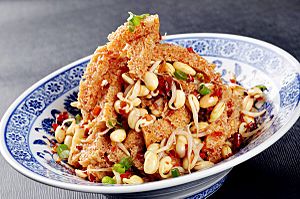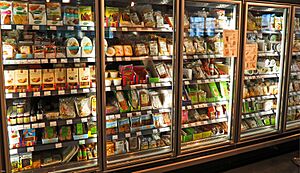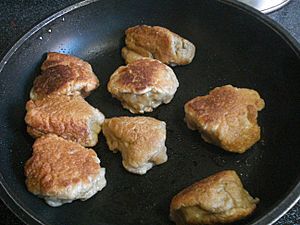Seitan facts for kids
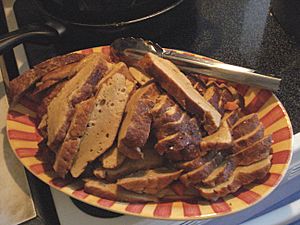
Slices of roasted seitan
|
|
| Main ingredients | Wheat gluten |
|---|---|
Seitan is a special food made from gluten. Gluten is the main protein found in wheat. It is also known by other names like wheat meat or gluten meat. In some Asian countries, it's called miànjīn (Chinese) or fu (Japanese).
To make seitan, you start with wheat flour dough. The dough is washed with water until all the starch is gone. What's left is a sticky, stretchy mass of gluten. This gluten is then cooked and ready to eat.
Seitan is a popular choice for people who don't eat meat. It can be used instead of soybean foods like tofu. Some types of seitan have a chewy texture that feels a lot like meat. This makes it a great meat substitute.
You'll often find seitan in Asian cuisine, especially in vegetarian and vegan dishes. It's also common in Buddhist cuisine, where many people choose not to eat meat. Seitan has been used in cooking for a very long time, first appearing in China around the 6th century.
Contents
Discovering Seitan's Past
Seitan has a long and interesting history, starting in China. People there have been eating wheat gluten since the 6th century. It became a popular meat substitute, especially for followers of Buddhism. Many Buddhists choose a vegetarian diet.
One of the oldest mentions of wheat gluten is in a Chinese book from 535 AD. This book, called Qimin Yaoshu, talks about noodles made from wheat gluten. Later, during the Song Dynasty (960–1279), it was known as miànjīn.
Wheat gluten made its way to Western countries by the 1700s. Doctors in the 1830s even suggested it for people with diabetes. In the United States, it became more known in the late 1800s.
Understanding the Name Seitan
The word seitan comes from Japan. It was created in 1961 by George Ohsawa. He was a Japanese person who promoted a special way of eating called the macrobiotic diet. His student, Kiyoshi Mokutani, developed the wheat gluten product.
In 1962, seitan was sold in Japan. It came to Western countries in 1969. The exact meaning of seitan is not fully clear. But it might come from two Japanese words: sei (meaning "fresh" or "raw") and tan (from "protein").
Different Forms of Seitan
Seitan comes in many different forms, depending on where it's made and how it's prepared. Each form has its own unique texture and use in cooking.
Chinese Seitan: Miànjīn
In China, wheat gluten is called miànjīn. It means "dough tendon." It's believed to have started in ancient China as a meat substitute. This was especially true for Buddhist monks who were strict vegetarians.
One story says that chefs made imitation meat for Chinese emperors. The emperors would traditionally eat vegetarian for one week each year. Miànjīn is often deep-fried in Chinese cooking. This gives it a crispy outside and a great texture.
There are three main types of Chinese wheat gluten:
- Oil-fried gluten: This is raw gluten torn into small pieces and deep-fried. They become puffy balls, about 3 to 5 cm wide. They are golden brown and often cooked in savory soups or stews. Sometimes, they are called "imitation abalone." Larger fried balls can be stuffed with meat or tofu.
- Steamed gluten: Raw gluten is shaped into a long "sausage" and then steamed. This type is dense and can be off-white or light greenish-grey. It's torn into strips for recipes. When sliced thickly, it's called miàn lún ("gluten wheels"). Large blocks might be colored pink to look like vegetarian "mock ham."
- Baked spongy gluten: This type is like a sponge. It's made by making raw gluten rise, then baking or steaming it. It's sold in small blocks and diced for cooking. This gluten soaks up cooking liquids, making it very "juicy." Chinese kao fu has bigger air bubbles than Japanese yaki-fu.
You can also find miànjīn in cans and jars at Asian grocery stores. It's often marinated with peanuts or mushrooms. This canned gluten is often eaten with congee (rice porridge) for breakfast. Depending on how it's made, miànjīn can taste like pork, chicken, beef, or even seafood.
Japanese Seitan: Fu
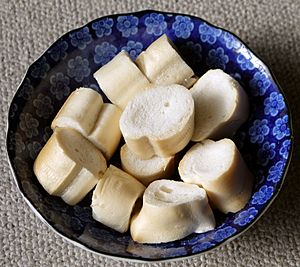
In Japanese cuisine, traditional wheat gluten is called fu. It's very important in Buddhist vegetarian cooking (Shojin ryōri) and tea ceremony meals. There are two main kinds of fu: raw nama-fu and dry-baked yaki-fu.
- Raw nama-fu: This is solid gluten mixed with glutinous rice flour and millet. It's steamed in large blocks. It can be shaped and colored in many ways, like autumn maple leaves or bunnies. These shapes make the cooked food look more appealing. Nama-fu is a key part of Japanese Buddhist vegetarian food. It can also be used in Japanese sweets called wagashi.
- Dry baked yaki-fu: This gluten is made to rise with baking powder and baked into long, bread-like sticks. It's often sold as hard, dry discs that look like croutons. Yaki-fu is usually added to miso soup and sukiyaki. It soaks up the broth and becomes light and fluffy. This is the most common type of fu you'll find in Japanese supermarkets.
Even though the macrobiotic diet started in Japan, seitan itself is not very well known there. When it is used, it's often called "gluten meat." Along with Tofu and Abura-age, fu can be a great meat substitute in Japanese dishes.
Vietnamese Seitan: Mì Căng
In Vietnamese cuisine, wheat gluten is known as mì căng or mì căn. It's prepared in a similar way to Chinese miàn jīn. Like in other Asian countries, it's a common part of the Buddhist cuisine of Vietnam.
Seitan in Western Countries
Since the mid-1900s, seitan has become very popular with vegetarians in Western countries. It's a great meat alternative. You can find it in blocks, strips, or shaped forms in many supermarkets. It's also sold in Asian food markets and health food stores.
Block seitan is often flavored with shiitake or portobello mushrooms. It might also have fresh coriander or onion, or be packed in a vegetable broth. Strip seitan can be eaten as a high-protein snack right from the package. Shaped seitan, like "ribs" or patties, often comes with barbecue sauce or teriyaki sauce.
Seitan is used in many vegetarian products. For example, a group called The African Hebrew Israelites of Jerusalem uses it in their vegetarian sandwiches. In North America, many brands offer seitan-based meat alternatives for restaurants and food services.
Vital Wheat Gluten
There is also a powdered form of wheat gluten called vital wheat gluten. It's sold as an additive for baking or to make seitan. When making seitan from this powder, people often add flavors like liquid smoke, smoked paprika, and garlic powder.
Vital wheat gluten is almost pure gluten with very little starch. When added to baking, it helps flours that are low in gluten, like whole wheat flour. It makes the dough more elastic and helps it rise better. It also makes the final baked product chewier. You only need a small amount, usually about 1 tablespoon for every 2–3 cups of flour.
How Seitan is Made
The powdered form of wheat gluten, called vital wheat gluten, is made by first adding water to hard wheat flour. This activates the gluten. Then, the wet gluten is processed to remove the starch. What's left is pure gluten, which is then dried and ground into a powder.
Seitan can be made from this vital wheat gluten powder or from regular hard wheat flour. If you use vital wheat gluten, you just add water to the powder to form the gluten, then cook it. Making seitan from wheat flour takes a bit longer. First, you make a dough by adding water to the flour. Then, you knead the dough under running water. This washes away the starch, leaving only the gluten. Finally, the gluten is cut into pieces and cooked by steaming, boiling, or frying.
Images for kids
See also
 In Spanish: Seitán para niños
In Spanish: Seitán para niños



